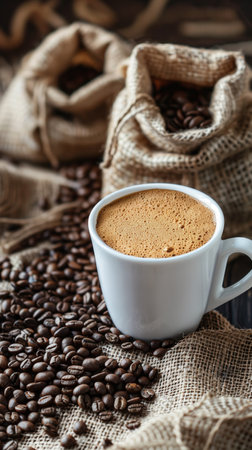Morning Rituals: Starting the Day with a Brew
For many American professionals, coffee is more than just a beverage—its a daily ritual that sets the tone for a productive day. The morning cup of coffee is often the first step in their routine, helping to shake off sleepiness and get into a focused mindset before tackling work responsibilities.
Why Coffee Is Essential in the Morning
Caffeine acts as a natural stimulant, boosting alertness and improving concentration. For busy professionals juggling meetings, deadlines, and decision-making, that early caffeine kick provides mental clarity and energy. Most people begin feeling its effects within 15 to 45 minutes after drinking.
Popular Morning Coffee Habits Among Professionals
The way American professionals enjoy their coffee varies by lifestyle and preference. Some opt for convenience, while others make it a mindful experience. Heres a look at common morning coffee habits:
| Coffee Habit | Description |
|---|---|
| Brew at Home | Many professionals start their day by brewing coffee at home using drip machines, French presses, or single-serve pods like Keurig. |
| Coffee on the Go | Busy commuters often grab a cup from drive-thru chains like Starbucks or Dunkin’ on their way to work. |
| Office Coffee | Some wait until they arrive at the office to pour a fresh cup from the communal coffee pot or espresso machine. |
| Café Routine | A few prefer stopping by a local café to enjoy their favorite brew while catching up on emails or reading news. |
The Mental Boost That Comes with Routine
The consistency of a morning coffee ritual helps create structure in a busy day. It signals the brain that its time to transition from rest to action. Over time, this habit can become a powerful trigger for focus and motivation. Whether its sipping quietly while journaling or pairing coffee with planning out the days tasks, these small routines contribute to mental sharpness and emotional readiness.
A Quick Look at Timing
The timing of that first cup also matters. Experts suggest that consuming caffeine between 9:30 AM and 11:30 AM can maximize its effectiveness, as cortisol levels naturally drop during this window—making caffeines effects more noticeable without disrupting the body’s natural rhythm.
Coffee as a Mindset Tool
Coffee isn’t just fuel—it’s part of a mindset. For American professionals, it’s not unusual to associate that warm mug with productivity, ambition, and readiness to take on challenges. The first sip often feels like flipping a mental switch—from groggy to goal-focused.
2. Coffee Break Culture in the Workplace
In many American workplaces, coffee breaks are more than just a chance to grab a cup of joe—theyre an essential part of office culture that supports both mental wellness and professional relationships. These short pauses during the workday allow professionals to recharge their minds, step away from screens, and often engage in casual conversations that can lead to new ideas or collaborations.
The Mental Reset
Coffee breaks serve as built-in moments for employees to reset mentally. Rather than pushing through hours of uninterrupted work, many professionals find that stepping away for a few minutes with a warm cup of coffee helps reduce stress and improve focus when they return to their tasks. This simple ritual can be especially important during high-pressure days or long meetings.
Common Mental Benefits of Coffee Breaks
| Benefit | Description |
|---|---|
| Mental Clarity | A short break with caffeine can clear brain fog and improve concentration. |
| Stress Relief | A pause away from the desk helps reduce stress and prevent burnout. |
| Mood Boost | Coffees natural stimulants can elevate mood and create a more positive mindset. |
Coffee as a Social Connector
Coffee breaks also play a big role in team building and informal networking. In American offices, its common to see coworkers gathering around the coffee machine or heading to a nearby café together. These moments often spark spontaneous discussions—from weekend plans to project ideas—that help build stronger work relationships and encourage collaboration across departments.
Coffee Break Interactions: Examples in the Workplace
| Scenario | Description |
|---|---|
| Coworkers Chatting by the Coffee Machine | A quick catch-up on current projects or sharing insights informally. |
| Coffee Walks with Managers | An opportunity for junior staff to connect casually with leadership. |
| Café Meetings Outside the Office | A relaxed environment for brainstorming sessions or one-on-ones. |
The Takeaway
Coffee breaks in American offices are far more than caffeine fixes—they’re a valued part of workplace culture that promotes mental sharpness and strengthens team dynamics. Whether it’s taking five minutes alone to refocus or chatting with a colleague over lattes, these everyday rituals play a key role in helping professionals stay productive, creative, and connected.

3. Caffeine as a Cognitive Enhancer
For many American professionals, coffee isnt just a morning ritual—its a powerful tool for staying mentally sharp throughout the day. The caffeine in coffee acts as a natural stimulant that helps improve focus, memory, and overall mental clarity. When used strategically, it can be a game-changer for productivity.
How Caffeine Works in the Brain
Caffeine blocks adenosine receptors in the brain, which helps reduce feelings of tiredness. At the same time, it increases dopamine and norepinephrine levels—neurotransmitters that help you feel more alert and focused. This makes coffee an effective way to kickstart your brain during long meetings, creative brainstorming sessions, or tight deadlines.
Smart Coffee Timing
Professionals often time their coffee intake to align with their work schedule. Instead of just drinking it first thing in the morning, they spread out their consumption to maintain mental performance during key parts of the day.
Typical Coffee Timing Strategy:
| Time of Day | Purpose | Coffee Type |
|---|---|---|
| 8:00 AM – 9:00 AM | Morning energy boost before starting work | Drip coffee or espresso |
| 10:30 AM – 11:00 AM | Sustain focus mid-morning when energy dips | Americano or cold brew |
| 1:30 PM – 2:00 PM | Fight post-lunch sluggishness and regain clarity | Latte or flat white |
The Right Amount Matters
While caffeine can enhance cognitive performance, too much can lead to jitteriness or anxiety. Most professionals aim for moderate consumption—around 200 to 400 mg of caffeine per day, which equals about two to four cups of brewed coffee. Staying within this range helps maximize benefits without unwanted side effects.
Caffeine Content by Coffee Type:
| Coffee Type | Average Caffeine (per 8 oz) |
|---|---|
| Brewed Coffee | 95 mg |
| Espresso (1 shot) | 63 mg |
| Cold Brew | 150–200 mg |
| Latte (with single shot) | 63 mg |
American professionals often treat their daily coffee as part of a broader strategy for staying mentally on point. By understanding how caffeine works and using it wisely throughout the day, they’re able to stay energized and focused when it matters most.
4. Balancing Buzz and Burnout
For many American professionals, coffee isnt just a morning ritual—its a tool for staying mentally sharp throughout the workday. But theres a fine line between getting that perfect energy boost and tipping into jitters or experiencing an afternoon crash. Finding the right balance is key to making caffeine work for you instead of against you.
Understanding Your Limits
Everyone’s body reacts to caffeine differently. While one person might breeze through three cups before lunch, another might feel anxious after just one. Professionals often learn their personal caffeine threshold through trial and error, adjusting their intake based on how they feel during the day.
Timing Is Everything
The timing of your coffee breaks can make a big difference. Drinking coffee too late in the day can interfere with sleep, while consuming it too early may lead to a mid-morning crash. Many professionals follow a strategic schedule to keep their energy levels consistent.
Popular Coffee Timing Strategies:
| Time | Purpose | Coffee Style |
|---|---|---|
| 8:00 – 9:00 AM | Wake-up boost | Drip coffee or espresso shot |
| 11:00 AM – Noon | Maintain focus before lunch | Latte or cold brew |
| 1:30 – 2:30 PM | Beat the afternoon slump | Iced Americano or light roast pour-over |
Choosing the Right Brew
The type of coffee matters too. Lighter roasts typically have more caffeine than darker ones, and brewing methods like cold brew tend to be smoother and less acidic, which some professionals prefer for all-day sipping without stomach discomfort.
Pairing with Food and Water
Coffee on an empty stomach can lead to jitters or upset digestion. Many working Americans pair their coffee with breakfast or a healthy snack to slow down caffeine absorption and avoid crashes. Staying hydrated is also crucial—coffee is a mild diuretic, so drinking water alongside it helps maintain energy levels.
Caffeine Balance Tips at a Glance:
- Know your limit: Track how much caffeine works best for you daily.
- Pace yourself: Spread out your coffee consumption instead of front-loading it in the morning.
- Add food: Pair your coffee with protein or fiber-rich snacks.
- Hydrate: Drink water throughout the day to stay balanced.
- Avoid late cups: Cut off caffeine by mid-afternoon to protect sleep quality.
By being mindful about when and how they consume coffee, American professionals are able to stay energized and focused—without falling into the trap of burnout or overstimulation.
5. The Rise of Specialty Coffee and Productivity Trends
In recent years, American professionals have developed a deep appreciation for specialty coffee, often seeking out third-wave coffee shops and artisanal roasters instead of settling for the standard office brew. This shift is about more than just taste—its part of a broader cultural trend where workers are becoming more intentional with their daily habits, especially those that impact focus and productivity.
What Is Specialty Coffee?
Specialty coffee refers to high-quality beans sourced through ethical and sustainable methods, roasted with care, and brewed precisely to highlight unique flavor profiles. Unlike mass-produced coffee, specialty coffee emphasizes craftsmanship and experience. In the workplace, this translates into a more mindful approach to caffeine consumption.
Coffee as Part of High-Performance Routines
American professionals are increasingly viewing their coffee rituals as part of a larger performance strategy. Choosing a specific single-origin pour-over or dialing in the perfect espresso shot can be both a mental reset and an intentional productivity tool. Many workers now pair their coffee breaks with specific work tasks or time blocks.
Common Coffee Habits Among High-Performing Professionals
| Coffee Type | When Its Consumed | Why Its Chosen |
|---|---|---|
| Single-Origin Pour Over | Morning deep work sessions | Smooth flavor helps ease into focus without overwhelming stimulation |
| Espresso Shot | Before meetings or presentations | A quick burst of energy to enhance alertness and confidence |
| Iced Cold Brew | Afternoon slump (2-4 PM) | Sustained energy without the crash; refreshing and convenient |
| Coffee Tasting Flight | Networking meetings at cafes | Sparks conversation and showcases refined taste |
The Role of Third-Wave Cafes as “Productivity Hubs”
Third-wave cafes arent just places to grab a latte—theyve become informal coworking spaces where professionals gather to work remotely, meet clients, or brainstorm ideas. These cafes often provide strong Wi-Fi, ample outlets, ambient music, and thoughtfully designed interiors that foster creativity and focus.
A Shift Toward Intentional Living
This rise in specialty coffee culture reflects a broader trend among American workers: living intentionally and optimizing daily routines for better mental performance. Rather than relying on caffeine as a crutch, many are choosing quality over quantity—aiming for clarity, focus, and sustained energy throughout their workday.


